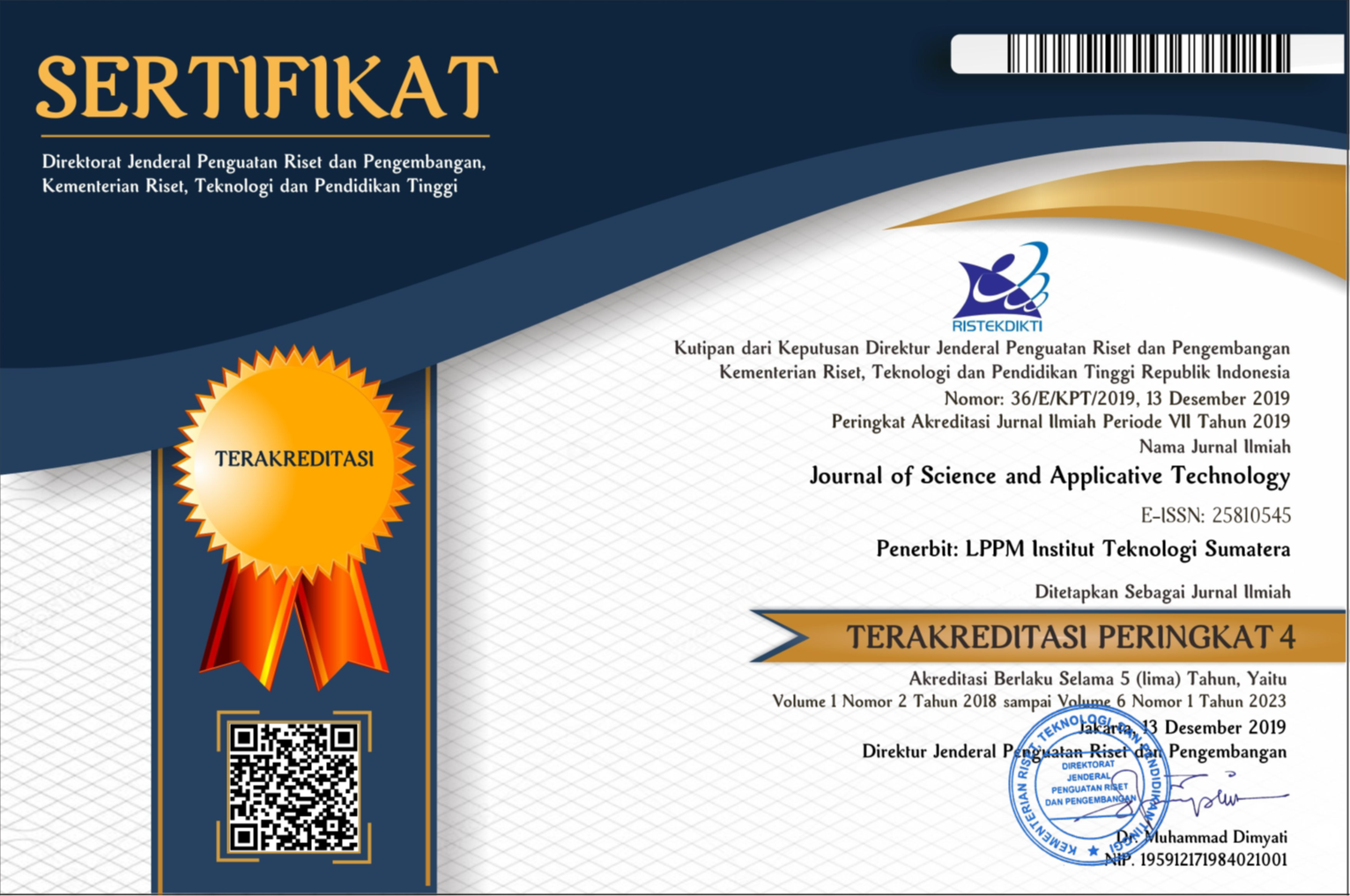Perancangan Bidai Infus Untuk Anak Usia Sekolah
Abstract
This research designed a hand infusion splint for school-age children with an age range of 7-12 years according to the anthropometry and contours of the child's hand so that children who underwent infusion on the hand did not experience medical complications during treatment or post-hospital trauma. The method used in the design of infusion splint for school-age children is Quality Function Deployment (QFD) and House of Quality (HOQ) to get design criteria according to consumer needs, while the software used, namely SPSS and Autodesk Professional Inventor to build models. The size of the infusion splint was determined based on the hand anthropometry of school-age children. The specifications of the hand infusion splint of school-age children according to the needs of pediatric patients have a length of 189 mm, a thickness of 9 mm, and a width of 46.3 mm for arm supports, and 37.1 mm for hand supports obtained from the highest priority value in the House of Quality, namely the design of the dimensions of the splint.
Downloads
References
[2] S. Fitriyanti, “Faktor Yang Mempengaruhi Terjadinya Phlebitis Di,” Fakt. Yang Mempengaruhi Terjadinya Phlebitis Di Rumah Sakit Bhayangkara Tk Ii. H.S. Samsoeri Mertojoso Surabaya, 2015.
[3] Muttaqin, Asuhan Keperawatan Klien dengan Gangguan Sistem Pernapasan. 2008.
[4] S. S. Dalal, D. Chawla, J. Singh, R. K. Agarwal, a K. Deorari, and V. K. Paul, “Limb splinting for intravenous cannulae in neonates: a randomised controlled trial.,” Arch. Dis. Child. Fetal Neonatal Ed., vol. 94, no. 6, pp. F394-6, 2009, doi: 10.1136/adc.2008.147595.
[5] S. C. . DeLaune and P. K. Ladner, Fundamentals of Nursing: Standards & Practice. 2010.
[6] M. C. Daugherty, C. T. Mehlman, S. Moody, T. LeMaster, and R. A. Falcone, “Significant Rate of Misuse of the Hare Traction Splint for Children with Femoral Shaft Fractures,” J. Emerg. Nurs., vol. 39, no. 1, pp. 97–103, 2013, doi: 10.1016/j.jen.2012.10.008.
[7] A. Y. O. F. de Breving, Ramadini Marniaty; Ismato, “Pengaruh Penerapan Atraumatic Care Terhadap Respon Kecemasan Anak Yang Mengalami Hospitalisasi Di RSU Pancaran Kasih GMIM Manado dan RSUP Prof. Dr. R. D. Kandou Manado,” eJournal Keperawatan, vol. 3, pp. 1–9, 2015, [Online]. Available: https://ejournal.unsrat.ac.id/index.php/jkp/article/view/7450.
[8] Asrin, E. Triyanto, and A. S. Upoyo, “Analisis faktor-faktor yang berpengaruh terhadap kejadian plebitis di rsud purbalingga,” J. Keperawatan Soedirman, vol. 1, no. 1, pp. 43–54, 2006, [Online]. Available: https://media.neliti.com/media/publications/107260-ID-analisis-faktor-faktor-yang-berpengaruh.pdf.
[9] O. J. Hines, “Schwartz’s Principles of Surgery, 9ed.,” Ann. Surg., 2010, doi: 10.1097/sla.0b013e3181d56ad3.
[10] J. R. Cameron, J. G. Skofronick, R. M. Grant, and R. L. Morin, “Physics of the Body,” Med. Phys., vol. 27, no. 2, p. 425, 2000, doi: 10.1118/1.598847.
[11] D. Hockenberry, M. J. & Wilson, Wong’s essentials of pediatric nursing. 2009.
[12] M. J. Hockenberry and D. Wilson, “Wong’s Nursing Care of Infants and Children,” in Mycological Research, 2015.
[13] F. Hamdani, “Hubungan Dukungan Keluarga Dengan Tingkat Nyeri Saat Pemasangan Infus Pada Anak Prasekolah Di IGD RSU PKU Muhammadiyah Yogyakarta Tahun 2010,” 2015.
[14] A. Fakhrurrizal, “Pengaruh Pembidaian Terhadap Penurunan Rasa Nyeri Pada Pasien Fraktur Tertutup Di Ruang Igd Rumah Sakit Umum Daerah A.M Parikesit Tenggarong,” J. Ilmu Kesehat., vol. 3, no. 2, 2015, [Online]. Available: http://ojs.stikesmuda.ac.id/index.php/ilmu-kesehatan/article/download/16/34.
[15] R. N. Handayani and Murniati, “Pengaruh Pemberian Pediatric Vest, Pictorial Tool and Modification Room Pada Anak Dengan Hospitalisasi Di RSUD Ajibarang Kabupaten Banyumas,” MUSWIL IPEMI Jateng 2016, no. 1, pp. 188–193, 2016, [Online]. Available: http://jarlitbangnov.bappeda.jatengprov.go.id/index.php?ref=publication&mod=doc&id=15375.
[16] P. A. Potter and A. G. Perry, Buku ajar fundamental keperawatan: konsep, proses, dan praktik. 2005.
[17] Mariyam, “Tingkat Nyeri Anak Usia 7-13 Tahun Saat dilakukan Pemasangan Infus di RSUD Kota Semarang,” J. Keperawatan Anak, 2013.
[18] A. Griffin and J. R. Hauser, “The Voice of the Customer,” Mark. Sci., vol. 12, no. 1, pp. 1–27, 1993, doi: 10.1287/mksc.12.1.1.
[19] K. N. Otto and K. L. Wood, “Product Evolution: A Reverse Engineering and Redesign Methodology,” Res. Eng. Des., vol. 10, no. 4, pp. 226–243, 1998, doi: 10.1007/s001639870003.
[20] L. P. Sullivan, “Quality Function Deployment,” Qual. Prog., vol. 19, no. 6, pp. 39–50, 1986.
[21] K. Ulrich, “Perancangan dan Pengembangan Produk,” Irwin McGraw-Hill, 2001.
Copyright (c) 2021 Journal of Science and Applicative Technology

This work is licensed under a Creative Commons Attribution-NonCommercial 4.0 International License.
All the content on Journal of Science and Applicative Technology (JSAT) may be used under the terms of the Creative Commons Attribution-NonCommercial 4.0 International License.
You are free to:
- Share - copy and redistribute the material in any medium or format
- Adapt - remix, transform, and build upon the material
Under the following terms:
- Attribution - You must give appropriate credit, provide a link to the license, and indicate if changes were made. You may do so in any reasonable manner, but not in any way that suggests the licensor endorses you or your use.
- NonCommercial - You may not use the material for commercial purposes.
- No additional restrictions - You may not apply legal terms or technological measures that legally restrict others from doing anything the license permits.





















